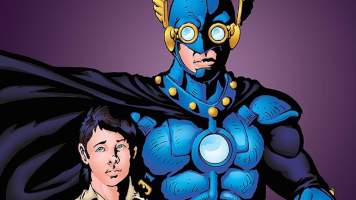Written by Cynthia Brideson
Portions of this article were taken from an interview posted by Michael Barnes on learnfasthq.com on January 6, 2015.
Imagine that you can’t discern another’s motives, expression, or actions. It’s like you’re watching a mime, but his expressions and gestures do not align with what you assume he is trying to communicate. If only people had thought bubbles above their heads, you might sigh.
Many children, as well as adults on the autism spectrum, find themselves in this predicament. Perhaps this is why a great many of them find comic books not only enjoyable and easy to understand but also useful learning tools.
Dave Kot, the founder of the non-profit organization “Autism at Face Value,” is on the high functioning end of the autism spectrum. He has created a comic book, FaceValue, tailored for those with autism. The comic book serves a dual purpose: to allow those with autism to feel included/represented and to teach empathy to their neurotypical peers. Kot has written the first comic book in the world with a hero who has autism.
Kot says, “At worst, the comics are just family fun and entertainment. At best, autistic kids have a hero like themselves. They can understand what autism is or what it isn't, relate to situations and be open to positive communications about autism”. The comic stories are set in the future, in the year 2072, and include an interesting cast of characters. Michael is the main character, and he interacts with an array of bullies, crime fighters, and friends/fellow people with autism.
Kot uses a number of literary devices to tell the stories and communicate with autistic kids. These include one he calls a “social throat punch commentary” in which the text in thought bubbles and even complete pages are upside down. That is his attempt to have readers look at an individual with autism differently than they may have expected. The faces of some characters have been deliberately drawn to emphasize the facial features of people with various emotions like anger, fear, surprise, and sadness. This is designed to help kids with autism better recognize emotions in others to help their understanding and communication. Kot says: “With my clients, I would look over what their general presenting problems would be - bullying, anxiety, depression and so on. What we did during sessions, on sheets of scrap paper, notebook paper, or whatever was available, was to describe the facial features of individuals or even the clients themselves using mirrors, and role-playing between us. I started to teach the kids self-regulation, recognizing those body triggers for when they were feeling sad or angry themselves. And building that through social learning theory, found it to be a very effective technique. I was able to typically discharge clients a little sooner than most.
I kind of built a reputation of being able to develop a very succinct, almost common sense approach to understanding others' expressions and build empathy. What I was really happy with was some-thing I hadn't predicted would happen. I saw kids begin to build predictive empathy.
They started making those connections. I was really impressed that this simple, intuitive idea is multicultural, does not discriminate against age or gender. A person in Australia who is angry looks like a person in Alaska who is angry.
So we started to take those ideas and made them into a comic book using the “steam punk genre”. It's an interesting blend of the Victorian era, England modernity. So it just gave us an opportunity to play with history, to play with new science., and time travel.
So by 2072, we'd cured lots of diseases. We'd cured poverty and hunger, and a lot of the social ills of the world. Mankind had learned from its mistakes and decided to put all efforts together to make a better society.
But the one problem we still have is prejudice and misunderstandings. So that is where the Zephyr comes into play. Zephyr is actually Michael from the future.
During this inter-galactic invasion, he goes back in time to save himself. So when we talk about having the first featured comic book hero with autism, yes, it is a little school-aged boy, but it is also the grown crime-fighting, costumed hero, the Zephyr.”
Kot goes on to explain:
“I wanted kids to be able to talk about autism. We understood that looking at a lot of resources, there is very little to provide a young person with autism to explain how autism might be. And in our comic books, we include activity pages, everything from finding the number of spy bots throughout the issue to questions to ponder like: who’s the worse bully, Edge or Claudia?”
We're taking this as an opportunity to really focus on sensory perceptions and challenges. The character will overcome some of the sensory overload challenges inherent in his autism to still be a hero and still save the day.
What does it feel like to be me, a person with autism who is writing these comic books?
... I've been fighting insomnia for a while now. And there's a good reason. I can't seem to turn off my brain sometimes. That's some of the challenges inherent in my autism. I was diagnosed as an adult later in life.
For me, that's more of an "Aha!" moment when I began to understand why some social relationships and experiences seem like failures. It wasn't a failure. It was just the wrong way of doing it at that time.
I could have been more successful by applying other strategies, but I just kept putting my head against the wall and thinking that was the only way to get a girlfriend or to get a job or things of that nature.
And the social challenges that I experienced I'm now learning that there's never just one solution to a problem. You can look at it from multiple angles and being a professional helper helping others, I also helped myself to see some of these opportunities that are available.”
“There is nothing I would change about myself,” he says. “Autism is a part of who I am. How I see things,” he says. Kot didn’t receive his diagnosis until he was an adult.
FaceValue’s first issue was a smash and was picked up by Diamond, The biggest comic distributor in the world. The second issue of Kot’s comic book expanded to feature a non-verbal autistic female character, Myra.
“I wanted to address issues related to girls with autism,” Kot says. “Girls are often diagnosed later or are often undiagnosed. “Myra wears black in public. Most of society doesn’t see her. At home, she wears a bright rainbow-colored kimono.”
Kot concludes that the primary lesson taught in his work is: “Feel safe, feel wanted, and you’ll be successful.”

